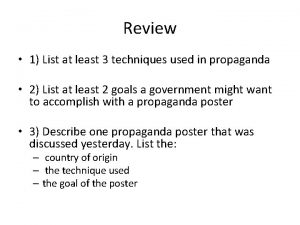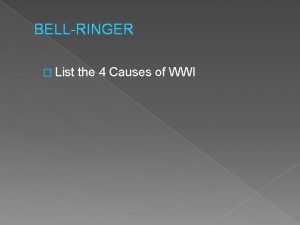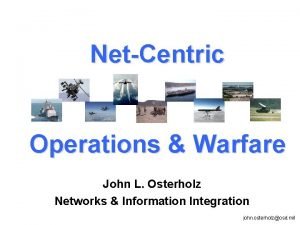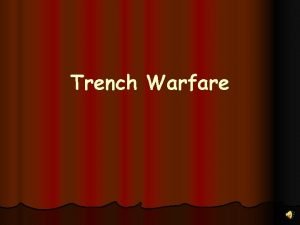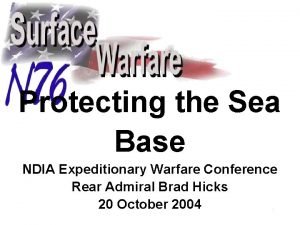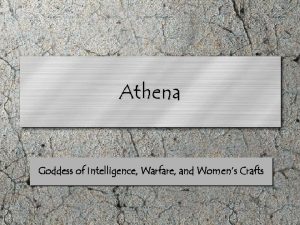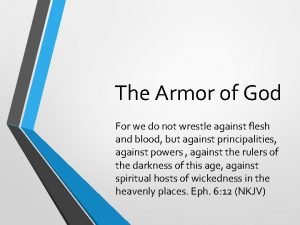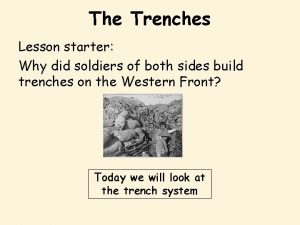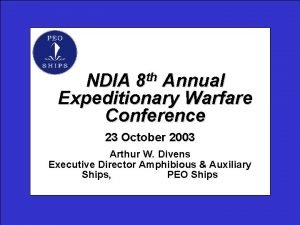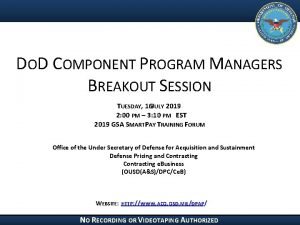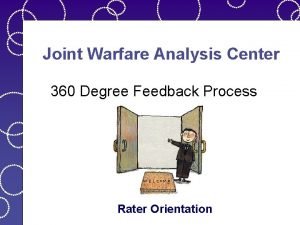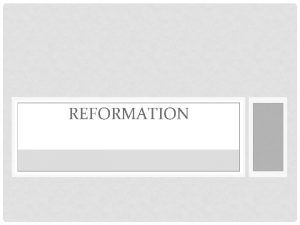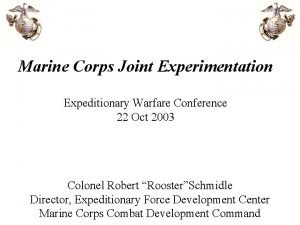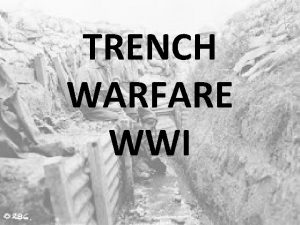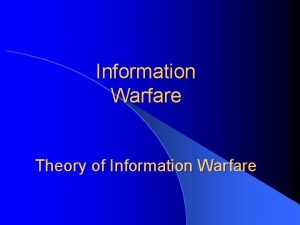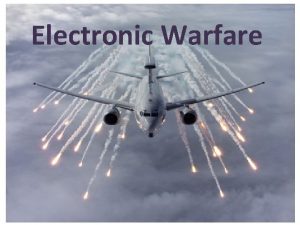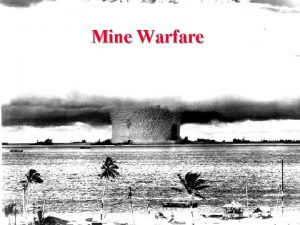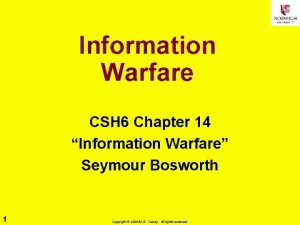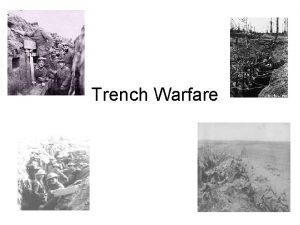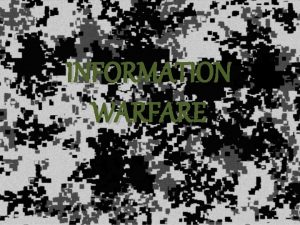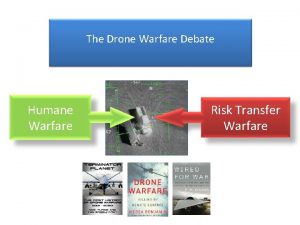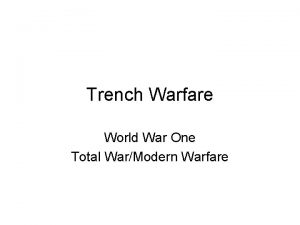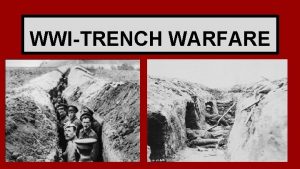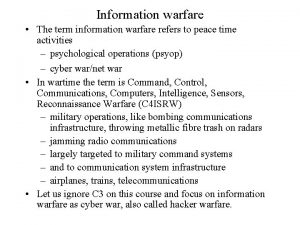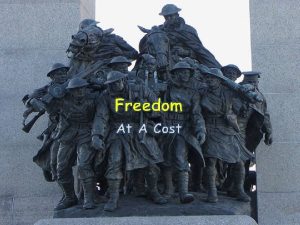A Look into the Future of Warfare The




































- Slides: 36

A Look into the Future of Warfare: The Joint Battlespace Infosphere Harold W. Carter University of Cincinnati http: //www. ececs. uc. edu/~hcarter

"The Internet is like a weapon sitting on a table ready to be picked up by either you or your competitors. ” (Michael Dell) “Similar web-based systems will be cheaply available to U. S. adversaries from global vendors. … if the U. S. goal is information superiority, there is no option but to plunge into the issues of weboriented C 2. ” (1999 AF SAB, “Building the Joint Battlespace Infosphere”) 2

Commander’s Perspective Total situational awareness Right forces at the right time The World Has Changed…To Meet Our Responsibilities we must: Assemble disparate forces and Leverage Information for the Warfighter resources into one joint tailored force rapidly and effectively to employ anywhere Collaborative Facilitate in the world planning and post crisis execution Global Grid reshaping 1999 SAB Study: “Building the Joint Battlespace Infosphere” 3

Information Management Problem l Current C 2 ISR tools only get us part way there – Large, monolithic, rigid enterprises – Unique information infrastructures – Interoperability issues – System admin & configuration overhead l Decision-maker must filter & aggregate l Kosovo Lessons: – “Info fatigue” – “Cyber-rubbernecking” l !! Decision Maker AOC GCCS ? GDSS DCGS TBMCS Brand new enterprise systems cost-prohibitive (time & $$) 4

http: //www. sab. hq. af. mil/Archives/index. htm

JBI Basics The JBI is a system of systems that integrates, aggregates, & distributes information to users at all echelons, from the command center to the battlefield. The JBI is built on four key technologies: l Information exchange – Publish/Subscribe/Query l Transforming data to knowledge – Fuselets l Distributed collaboration – Shared, updateable knowledge objects l Force/Unit interfaces – Templates » Operational capability » Information inputs » Information requirements 6

Publish & Subscribe • Publish: Installation of Objects in “Catalog of Published Objects” maintained by specialized Publication Services also maintain lists of pending Subscriptions • Subscribe: Subscriptions specify metadata values that must match corresponding values in newly Published Objects - forward looking in time • Query: Like Subscription, but without automatic triggering - backward looking in time • • Publication Service Processing: - Test each new Published Object against all pending Subscriptions - Test each new Query against all previously Published Objects Publish Object Subscribe JBI Client Publish Publication Service Search: Trade-off Timeliness against Accuracy in Information Delivery 7

JBI Fuselets • JBI Clients that create new knowledge derived from JBI information objects • Small programs that publish JBI objects by refining or fusing information in a relatively simple way • Capture simple decision logic which can be expressed in a natural way (e. g. rules) • Created using scripting languages (e. g. Java. Script) or simple programming tools to adapt JBI information flows to dynamic mission needs • Obtained from a library, configured, and placed in service to accomplish particular job in a JBI • Not currently viewed as either mobile or intelligent 8

Example: fuselets that aggregate • Each air base publishes a “base status” object to the JBI. A fuselet that has subscribed to this type of object is triggered and publishes an aggregate “mission base status” object. Ramstein status Publish Aviano status Taszar status Fuselet Subscribe Mission base status • Complex aggregation is achieved by cascading fuselets, forming higher-level knowledge. • Represents challenges in control. 9

Objects and Metadata METADATA ATTRIBUTES AND VALUES OBJ-ID: TBMCS-59 Time-stamp: 06222001 JBI-CLIENT FLEX-1765 A SECURITY: OBJ-TYPE: GEO: 167/34/27 W-45/22/57 N ATO-MSG UNCLAS OBJECT • Set of attribute/value pairs DECISIVE-HALT-2001> • <CAMPAIGN-ID Standardized metadata <MSGID ATO/TACC> • <AIRTASK Mission-standard object RECONNAISSANCE> type definitions <TASKUNIT 63 -TRS/KXXQ/DET-1 -FOL> <MSNDAT AF 0025/-/PHICO-10/1 RF 4 C/REC> <RECDATA 8 AA 001/PRY: 2/301500 Z/-/SLAR> <TRCPLOT 420035 N 0153545 E/RAD: 50 NM> <INGRESS-ROUTE <COMMAND-GUIDANCE > > 10

Force Template Information handshake between the JBI and the combat unit (defines subscribe and publish data to JBI). Information interface requirements: • Information required to accomplish mission • Example: Required accuracy of targeting information C 2 and ISR capabilities: • ISR inputs to JBI • Example: weapons pod camera Force capabilities: • Sortie rates (steady state and surge) • Employment restrictions • Munitions (TLAMs) • Current readiness state • Logistics requirements Force Template 11

Force / Unit Templates descriptions of military units that are to be integrated into the JBI • Information requirements l Describes pub/sub exchange; based on IERs • Information products/outputs Drives JBI reconfiguration to incorporate new • Communications requirements lunits and their native IM • Computing systems Support Unit • Force employment capability • Information l Comprehensive • Ammunition inventory Information “handshake” requirements Combat Unit l Software • Fuel requirements • Personnel requirements JBI • Information products/outputs • Communications requirements • Computing systems • Mandatory unit subscriptions • Mandatory unit publications • Network routing information 12

C 4 ISR and the JBI Command Fusion Products Combat Support Products Planning/ Execution Products Command Guidance Common User Information Products & DBs Transform Control Battlespace Info. Sphere. Query Subscribe Publish Task Centric Presentations Representation Automatic Collaborative Formatting & Problem Filtering Solving Info Support Execution Automatic Data Capture Combat Support 13

SENSORS Architectural Concept C o n n e c t o r s Subscribe Global Grid, Web, Internet, …. TBMCS ABCS GCSS GCCS-M Meta data JBI Subscription Broker Publish AFATDS Meta data Query B Personnel A T BDA T L E Orders of Battle S P A Weather C E Intentions I N Targets F Etc. . O ? ? ? JBI Query Broker JBI Repository JBI Management Services Coalition partners ACCESS SYSTEMS JBI Platform

JBI Operational Architecture • Focuses on the tasks, information flows, and operational elements that meet the warfighter needs • Defined through such products as: – operational concept documents – command relationship charts – activity models – information exchange requirements – required capabilities matrices • Develops enterprise view and representation of operational processes 15

JBI Systems Architecture • Identifies the information systems components and interconnections that make up the JBI development and execution environment. • JBI platform, the run-time component that implements information exchange among C 2 ISR systems and fuselets • Systems needed to implement the entire JBI lifecycle – Unit Infospheres – Mission-specific JBIs. • Includes tools and reuse repositories to support – Conceptual modeling – Object modeling – Allocation of object model component publication, subscription & query responsibilities – Performance modeling 16

JBI Technical Architecture • Identifies applicable portions of existing standards – Joint Technical Architecture • Establishes new standards where there are voids – Standard template for stating JBI object models – – Baseline common object models Mission-specific JBI object models Unit infosphere object models Individual C 2 ISR system object models – Standard template for stating publication, subscription, query, and query response responsibilities at the same levels as for the object model – Interface protocols that define the service calls between the JBI platform and all systems that interface with the platform, including C 2 ISR systems and fuselets 17

JBI Platform Architecture JBI Clients Connector Global Grid, Web, Internet, …. Meta data ? Meta data JBI Query Broker JBI Repository JBI Subscription Broker JBI Management Services Access Policy ACCESS JBI Platform 18

Advanced JBI Platform: Required JBI Infrastructure l l JBI Infrastructure Services / Capabilities Layer – Publish / Subscribe / Query Mechanisms & Support Services – Information Object Representation / Types / Schemas / Metadata / Ontologies – Distributed Object Spaces / Virtual Repositories – White & Yellow Pages for Information & Service Location – Transform – Fuselet Construction, Modification, Composition, and Control Services – Control – JBI Stand Up/Down Services – JBI Client Protocols, Certification & Registration Services – Unit / Force Join & Depart Services – JBI Access, Performance, Control, and Maintenance Services – Information Flow Level Qo. S Management – Information Assurance / Pedigree Capture / Security & DIW World Wide Web Layer Internet Layer Global Grid Communications Layer 19

JBI Payoffs The JBI will revolutionize the way we… DESIGN: – Concentrate design effort on ops functionality Faster, cheaper – Integrate at information level -- focus on content vs. format; de-couple data & applications ACQUIRE: – Competitive market economy for info services & products within the JBI; no single-vendor solutions Best of breed – Rapid plug-n-play, standards-based insertion of innovative functionality and technology DEPLOY: – Build & evolve agile JTF info framework driven by campaign CONOPS & dynamics of ops environment -- just like force structure EMPLOY: – Timely decision-making from decision quality information Customized, Adaptive Services Information Dominance – Unity of effort through shared understanding Enabled by Web Infrastructure 20

JBI Impact l Design – JBI abstraction barrier isolates information layer from delivery concerns – Designers focus on information needed for decision making – Enables designers to emphasize information availability, not location & ownership – Emphasize information content, not data format l Acquire – “Plug & Play” integration at the information level – Open competition on basis of functionality & performance “best of breed” clients – C 2 ISR Product lines, not company store – Low cost of entry for innovators – High payoff through information-level synergy – Evolution of functionality through rapid new technology insertion (e. g. , MP 3) 21

JBI Impact (Concluded) l Deploy – “Plug & Play” C 2 ISR component selection & assembly driven by current mission requirements – Information system architecture (the “Information Plan”) codesigned with the CINC’s campaign plan, force structure plan, deployment plan – “Designed” from the start to be responsive to CINC policy & goals – Agility in the face of changing missions, roles, coalitions – Economy of functionality l Employ – See Gen Mc. Carthy’s 1999 JBI summer study outbriefing ! – The existence of a CINC-orchestrated “Information Plan” implies: – Plan execution – Real-time execution assessment – Replanning – Better decisions, faster 22

Current Status l AC 2 ISRC “Wright-Flyer” JBI – “Integrated” Cat III for JEFX 00 – ISR Battle Management scenario l JBI Task Force – Mapping technical/operational way ahead; securing acquisition funding – Assembling joint partners wf-JBI MOE/MOP l Concept Validation Prototypes (Y-JBIs) – Explore design space – Identify most viable components for operational spirals – Goal is relatively inexpensive evaluation & idea generation YJBI-1’s Design space wf. JBI 23

JBI Evolution l l Provides an integrating substrate of • information management services to link all C 2 functionality New solutions “plug-in” without • rebuilding all service layers TBMCS GCCS Supplants old infrastructures while providing migration path for existing C 2 systems Significant acquisition, deployment, and employment gains GDSS Emerging TBMCSGCCSGDSS C 2 tools Infrastructure Y-JBI Infrastructure Joint Campaign Planning JBI-1 Mobility Planning Effects Battlespace Based Awareness Ops WEB ENABLED Dissolves Stovepipes & Delivers Seamless Access to Information 24

SAB Recommended Technology Investments Commercial Tech: t en o em D ts m e& q yp R ot ve ot vol Pr E • E-commerce JBI-1 Solutions • Enterprise YJBI-1 Application Integration (EAI) Middleware • Information Assurance & Survivability m op el s ev ces l D ro ira P JBI-2 Sp • Web Technology: XML, XSL, XQL Do. D S&T: • Intelligent Agents • Distributed Storage, Indexing, & Retrieval • Digital Libraries • Auto Data Capture & Info Extraction • Data Warehousing • Immersive Virtual Environments • Advanced Data/Sensor Fusion 2001 Today 2005 Near-Term 2010 Long-Term • Warfighter Connectivity LEVERAGE E-BUSINESS SOLUTIONS WITH ROBUST DOD S&T INVESTMENTS 25

SAB Specific Recommendations l l l Immediate low-cost prototypes: AFRL/AC 2 ISRC JBI Platform technical architecture: ESC Evaluation of relevant COTS: ESC Military requirements for C 2 Info Integration: AC 2 ISRC Common Representation/Templates: DISA/ESC Long term research: – Advanced JBI Platform: DARPA with AFRL – Advanced fusion concepts: AFRL with DARPA – Information assurance: DARPA with AFRL – Agent-based technology: DARPA with AFRL – Advanced data survivable systems: DARPA/AFRL – Active networks: AFRL – Dynamic User Modeling: DARPA/AFRL 26

JBI High-Level Approach JBI = f(COTS + GOTS + Do. D-specific R&D) COTS T&E Do. D R&D + GOTS T&E Integration & Experimentation Integrated Feasibility Demonstrations / Experiments (IFD/E) Adopt / Adapt / Develop to maintain low cost of entry; “Buy, don’t Build” 27

JBI Roadmap 2000 2001 2002 2003 2004 CONOPS JEFX 02 2006 CONOPS Technical Architecture JEFX 00 2005 CONOPS Technical Architecture JEFX 04 2007 Technical Architecture JEFX 06 YJBI-1 a wf. JBI YJBI-1 b YJBI-1 c JBI-2 JBI-1 Block 10 JBI-1 Block 20 YJBI-1 d JBI-1 Block 30 JBI Experimental Testbed COTS Insertion + Foundational Do. D Science & Technology DARPA 28

Long-Term Research Areas Summary • Advanced JBI Platform – Fundamental “core services” for Publish, Subscribe, Query, Transform and Control – Common Representation for information standardization • Advanced Fusion Concepts – • Integrate traditionally separate research communities for fusion, planning, and IW for a new form of COP Information Assurance & Survivability – Novel approaches (e. g. , NLP and semantic modeling) needed to control exchange of information between classification and coalition domains: MLS/MSL remain critical requirements despite failures of traditional approaches – Vulnerabilities/challenges introduced by JBI-related technologies; e. g. , Shared-spaces (Java. Spaces/Jini); XML; Distributed components (CORBA, EJB, Agents, etc. ) 29

Long-Term Research Areas Summary (Continued) • Agent-Based Technology – – – • Information Acquisition and Storage – – • Agents with network awareness for bandwidth adaptation Enhanced mobility, control & coordination, and interagent communication Scalability & agent security issues Automatic data capture & info extraction services Advanced data storage & retrieval (e. g. , geospatialtemporal indexing) Effective Interfaces – Context Understanding – Multiple, simultaneous-user, interactive environments – Cross-language transformation for seamless coalition collaboration, preferably in real-time – Near real-time, dynamically-composable simulations to support visualization and decision-making 30

JBI “SWAT Team” l Goal: Seize the JBI opportunity to provide the research, development and technical leadership necessary to formulate and execute a comprehensive program of research and development of the technical architecture for C 2 ISR by: – Engaging in early experimental prototyping of JBI Platform services as a basis for idea generation, concept refinement, and evaluation. – Performing in parallel systems studies and analysis of long term JBI Platform architecture focusing on downstream functionality for spiral development – Providing the catalyst for the refocus of on-going AFRL/IF R&D activities, or the initiation of new AFRL/IF R&D activities, in partnership with others, in the long-term JBI technology areas recommended by the SAB 31

JBI “SWAT Team” l Small cadre of full time senior S&Es – Senior mentor – Large support group of part time S&Es from across directorate l Focus on experimental exploration of JBI Platform design space – JBI Core Services – l l JBI Technical Architecture Build & maintain AFRL/IF node of JBI Testbed Serve as hub of AFRL IF Directorate JBI activities – Bridges to each Division – Outreach to each Branch – Long Term JBI Research and other JBI enabling R&D – Requirements pull for the JBI – Early access to evolving JBI concepts in the Testbed l Collaborate and support outside JBI activities – – – DARPA AC 2 ISRC ESC/MITRE AFRL/HE Other Service Labs 32

Testbed Purpose l Host and facilitate full evolution of the JBI l Support multiple prototypes (incl. wf. JBI) for collaborative development and experimentation l Provide an integration environment for legacy and emerging C 2 ISR systems l Support industry IR&D efforts with access to C 2 architectures & systems l Provide JBI component developers regular access to evolving JBI Services – mitigates risk for downstream insertion l Support operational assessment and evaluation 33

Distributed Testbed Nodes ESC - Hanscom l System Architects ARFL - Rome l Science & Technology Developer – R&D for enabling technologies – System and Technical architecture specifications – DARPA agent & transition vehicle – Standards & Protocols l Experimentation & Evaluation Node l Experimentation/Evaluation Node – COTS/GOTS ring-out and analysis – Platform assessment & prototype development – Metrics collection with operational systems • Integration Partner w/ ESC OSC l Integration Partner with AFRL – Emerging / legacy systems into JBI l Requirements Analysis & Transition Langley – JBI component technologies – Translation of ops to technical reqts – Joint functional components onto JBI service layers – Support transition of JBI services/ l Management / Assessment Center components to operational – Requirement communities fielding – Operational communities – Management communities C 2 B - Hurlburt DBCC - Nellis l Experimentation / Demonstration Site l Large-Force Employment Node – Robust, realistic scenarios – Operational ring-out l Operational Process Hub – Develop / refine new CONOPS to drive JBI capabilities l Operational Assessment Center – Access to warfighter users on continuous basis – Full array of fielded systems and architectures – Established feedback and evaluation processes l Warfighter Assessment Center – Access to warfighter users on continuous basis – Full array of fielded systems and architectures – Established feedback and evaluation processes 34

Summary: JBI Vision Globally Interoperable Information “Space” that … Aggregates, integrates, fuses, and disseminates tailored battlespace information to all echelons of a JTF Links JTF sensors, systems & users together for unity of effort Decision-Quality Information Focuses on Decision Enables Affordable -Making Technology Refresh Integrates legacy C 2 resources Leverages Emerging Commercial Technologies 35

Questions? "Information superiority becomes a precondition for fighting to achieve air and space superiority, " Lt. Gen. Liu Shunyao, Chief, China Peoples Liberation Army Air Force 28 Feb 2000, AW&ST (“Chinese War Plans Emphasize Air Force's Offensive Role”) 36
 Look down look up
Look down look up Future continuous and future perfect
Future continuous and future perfect Future perfect future continuous
Future perfect future continuous Ephesians weapons of warfare
Ephesians weapons of warfare How did the treaty of versailles affect postwar germany
How did the treaty of versailles affect postwar germany German unrestricted submarine warfare
German unrestricted submarine warfare Naval surface warfare center
Naval surface warfare center Ferris
Ferris Why were military leaders baffled by trench warfare?
Why were military leaders baffled by trench warfare? Battleground for spiritual warfare
Battleground for spiritual warfare Ptsd spiritual warfare
Ptsd spiritual warfare Our warfare is not against flesh and blood
Our warfare is not against flesh and blood The war to end all wars
The war to end all wars Navy special warfare physical training guide
Navy special warfare physical training guide Quantum warfare
Quantum warfare Trench warfare propaganda
Trench warfare propaganda Mayan warfare
Mayan warfare Undersea warfare conference
Undersea warfare conference M.a.n.i.a world war 1
M.a.n.i.a world war 1 Goddess of cleverness
Goddess of cleverness Spiritual warfare prayers
Spiritual warfare prayers Biological warfare pros and cons
Biological warfare pros and cons Define spiritual warfare
Define spiritual warfare Trench foot
Trench foot Ndia expeditionary warfare conference
Ndia expeditionary warfare conference Naval surface warfare center
Naval surface warfare center Joint warfare analysis center
Joint warfare analysis center Ancient warfare weapons
Ancient warfare weapons Adhd spiritual gift
Adhd spiritual gift Irregular warfare
Irregular warfare All warfare is based
All warfare is based Selective service act of 1917
Selective service act of 1917 Guerilla warfare
Guerilla warfare Spear in spiritual warfare
Spear in spiritual warfare Expeditionary warfare conference
Expeditionary warfare conference Guerilla warfare
Guerilla warfare Jewosu
Jewosu





